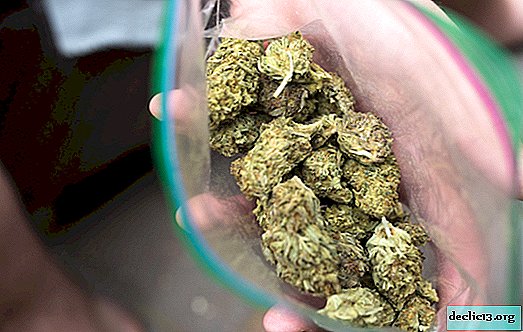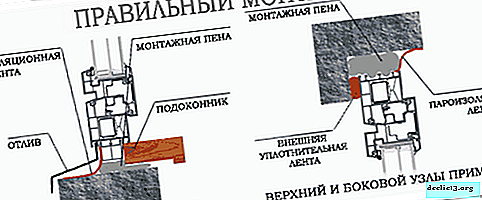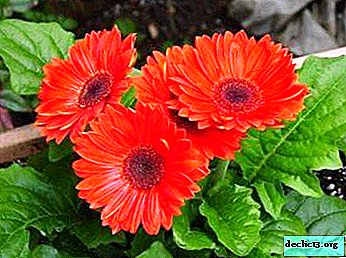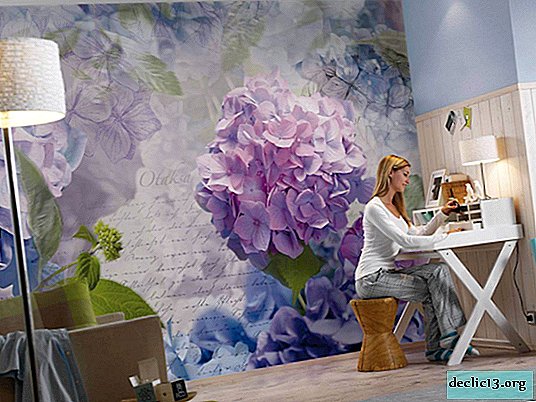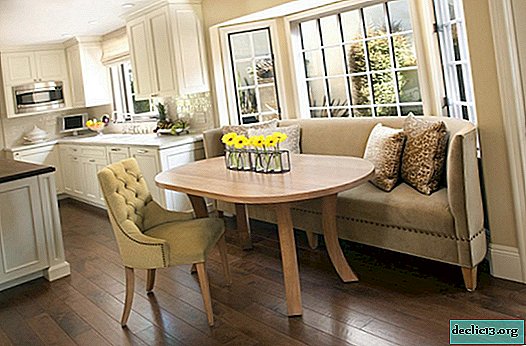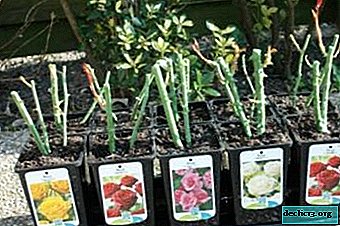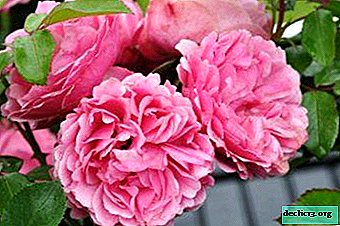Surprisingly beautiful - tulip-shaped pelargonium. All about origin, reproduction and care
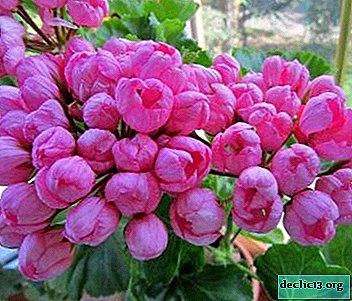
Tulip-shaped pelargonium is an amazingly beautiful representative of a large family. The unusual nature of the plant is that instead of the usual flowers, it has inflorescences resembling half-opened tulip buds. The plant looks extremely decorative, in addition, it does not require excessively careful care. Sometimes tulip-shaped pelargonium is confused with rose-shaped geraniums, but these are different species.
In the article we will consider the features of cultivation of tulip-shaped pelargonium, find out how to plant a plant, how to properly care for it.
The origin of the species and variety
For the first time, flower growers got acquainted with this amazingly beautiful plant in 1966, when tulip-shaped pelargonium was presented to the general public. An event took place in the USA where this elegant decorative variety of pelargonium was bred in the nursery of the Andrea family. They called the species tulip-like for the external similarity of inflorescences with the heads of tulips.
The first variety was named Patricia Andrea in honor of one of the members of the family of breeders, and in the next few years several more new varieties were bred. Note that this kind of pelargonium in selection is complex, therefore today only 14 of its varieties are knownincluding Marbaska Tulip, Tulip Emma and Red Pandora. The cost of the plant is quite high: on average, it will cost 400 rubles to purchase the rooted stem of a tulip-shaped pelargonium. For some rare varieties, the price reaches 700 rubles per cut.
As mentioned above, there are few varieties in this type of pelargonium - consider the two most popular: Marbaska Tulip and Tulip Emma.
Marbaska Tulip
This variety of tulip pelargonium has a pale pink color of the petals, is extremely decorative and sophisticated. To the edges of pale pink, the petals become dark pink, which gives the appearance of the plant even more charm.

Tulip Emma
The most beautiful variety: elongated beige-yellowish buds are grouped in groups of several inflorescences.

Appearance and photo
Tulip-shaped pelargoniums are very beautiful, they can become a real decoration of the front garden and any room. Note that among the varieties there are both ordinary and dwarf ones. Tulip-shaped pelargonium, depending on the variety, can have both smooth edges of the petals, and wavy, even jagged, terry. The inner side of the petals is always brighter than the outer, which gives the plant even greater decorativeness and sophistication.
Inflorescences are always collected in groups of 20-40 pieces: it turns out a kind of hat, consisting of many small inflorescences, "tulips". The color of the petals can be different: pink shades, burgundy prevail. On the outer part of the petals, streaks that are darker than the main background are usually noticeable.
As for the leaves, in this case they are quite dense, tough, have a glossy shine. The height of the plant varies from 30 cm to 70 depending on the variety.
Here are some pictures of tulip-shaped pelargonium flowers:





How to plant?
Consider the main points regarding the competent planting of tulip-shaped pelargonium.
Location and Lighting
Tulip-shaped pelargonium, like all its "brethren," prefers sunlight to shaded places. Note that the plant is therefore best kept on a well-lit windowsill, shaded from direct sunlight in the summer. If in winter, tulip-shaped pelargonium is provided with additional artificial lighting, then the plant can please its flowering in the cold.
Tip. Growing this pelargonium in the shade is strongly discouraged. With a lack of light, the shoots of the plant will begin to stretch in length, weakening and turning pale at the same time. The leaves also become pale, ugly, and the buds will not be able to fully open. Thus, the plant will lose most of its decorative effect.The soil
For the cultivation of tulip-shaped geraniums, it is recommended to use a ready-made soil mixture. However, you can mix the substrate yourself: for this it is necessary to take peat and garden soil in equal proportions. It is also necessary to add a little river sand to the resulting mixture to loosen the soil.
Since the tulip-shaped pelargonium does not tolerate stagnation of moisture, it is necessary to put a drainage layer of expanded clay pebbles on the bottom of the pot before pouring earth.
Care
 Along with its external decorativeness, tulip-shaped pelargonium is also unpretentious. Great care for this beautiful plant will not cause including for beginner gardeners. Despite the fact that pelargonium loves light, in summer it must be removed in the shade from direct sunlight in order to avoid burns. In winter, give artificial illumination. From a large lack of light, the plant fades, dries, and instead of flowering spends energy on growth. Next, we consider in more detail the main points of caring for tulip-shaped pelargonium.
Along with its external decorativeness, tulip-shaped pelargonium is also unpretentious. Great care for this beautiful plant will not cause including for beginner gardeners. Despite the fact that pelargonium loves light, in summer it must be removed in the shade from direct sunlight in order to avoid burns. In winter, give artificial illumination. From a large lack of light, the plant fades, dries, and instead of flowering spends energy on growth. Next, we consider in more detail the main points of caring for tulip-shaped pelargonium.
Watering
In summer, pelargonium needs to be hydrated much more than in winter. So, in the heat, the plant is supposed to be watered 3-4 times a week, in winter only once during the same period of time. When watering it is important to ensure that water does not accumulate in the pan under the pot - pour immediately, as you notice. The fact is that excessive moisture damages the plant, sometimes leading to the death of its roots.
Top dressing
Pelargonium is supplied with additional nutrition during the period of active vegetation - from spring and around October. It is recommended to use liquid nutrient solutions for feeding.
Important. For tulip-shaped pelargonium, one needs to choose complex compositions with a minimum nitrogen content, otherwise the plant will form a dense green mass, and there will be few or no flowers at all.Shaping a bush
Tulip-shaped geranium needs regular timely pruning, as well as pinching of the shoots. These operations are intended for:
- the formation of the desired compact form of the bush;
- activation of the formation of side shoots;
- enhancing the formation of flower buds.
As a result of pinching and pruning, the tulip-shaped geranium bush looks much more attractive and decorative, and its flowering is striking in its splendor. It is also important to remove dried inflorescences from the stems in time, so that new, fresh ones are formed in their place faster.
 If the buds began to open strongly, while losing the characteristic appearance of a tulip, they should be removed immediately, otherwise all the other inflorescences that have appeared again will be prone to the same "behavior". If the tulip-shaped geranium suddenly began to give a large number of flowers of the usual form, experienced flower growers are advised to cut the bush to the root. The plant will give new shoots and usually with the "right" flowers. Such a mutation suggests that the species characteristics of the plant in its genes are not sufficiently fixed during selection.
If the buds began to open strongly, while losing the characteristic appearance of a tulip, they should be removed immediately, otherwise all the other inflorescences that have appeared again will be prone to the same "behavior". If the tulip-shaped geranium suddenly began to give a large number of flowers of the usual form, experienced flower growers are advised to cut the bush to the root. The plant will give new shoots and usually with the "right" flowers. Such a mutation suggests that the species characteristics of the plant in its genes are not sufficiently fixed during selection.
The plant also needs to be protected from drafts. And if in the summer take pelargonium out into the open air, take care of protecting it from winds and rains.
Information. You should know that with improper care, tulip-like varieties of pelargonium become outwardly similar to representatives of ordinary varieties, that is, they lose their species characteristics.
To avoid this problem, you need to:
- regularly pinch the newly growing shoots;
- remove timely dried inflorescences;
- immediately remove those inflorescences that began to lose the shape of a tulip;
- protect the plant from drafts, which in this case are fatal.
Pests and diseases
Like all other cultivated plants, tulip-shaped geraniums are also at risk from pests and various diseases. Next, we consider in detail what diseases and harmful insects are dangerous for this plant in the first place.
Pests in this case are standard: whitefly, spider mite infect tulip-like pelargonium with the same frequency as other varieties of these plants.
 Of the diseases, we distinguish gray rot and rust of leaves - these diseases affect the plant more often than others. You can detect diseases at an early stage by seeing:
Of the diseases, we distinguish gray rot and rust of leaves - these diseases affect the plant more often than others. You can detect diseases at an early stage by seeing:
- the appearance on the leaves of white and reddish circles (rust);
- gray fluffy spots on the bottom of the leaves (gray rot);
- redness of leaves and stems (freezing).
The last disease is the result of hypothermia of pelargonium. This nuisance usually happens in winter, when a pot with a plant stands on a windowsill in the immediate vicinity of a window. And if everything is normal in relatively warm winter weather, then in frosts the plant is supercooled due to the leaves touching the glass.
Breeding
Pelargonium tulip-like propagates at home exclusively by cuttings. Due to the peculiarities of the bud structure, access to seeds is difficult, and the seed material of this plant is used, for the most part, only for breeding. Due to the difficulties associated with seed propagation of this type of pelargonium, today only 14 of its varieties are known - note that this is the result of half a century of selection work in this direction.
Tip. In order to get a full, healthy stalk, cut off apical shoots with several leaves from the mother plant. After cutting, the stalk is placed in water to grow roots. Note that the roots will grow back in a few days, and for this it will not be necessary to activate the process with any stimulants.The stem is rooted in an “adult” soil mixture, and immediately after planting, the container with the plant is put on a well-lit window sill. In general, the survival rate of cuttings of this plant is good.
So, we met with one of the varieties of pelargonium - tulip-shaped. This plant is remarkable for its spectacular appearance and non-capricious character. Having planted such a beauty at home, you can then enjoy her impeccable appearance and delicious aroma for a long time.




